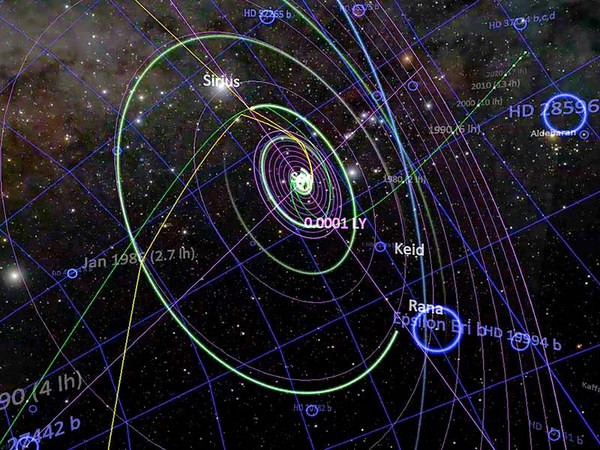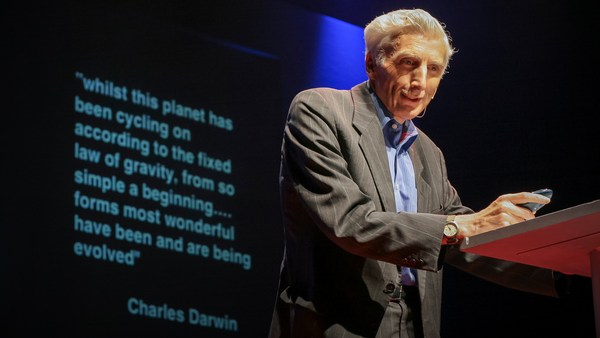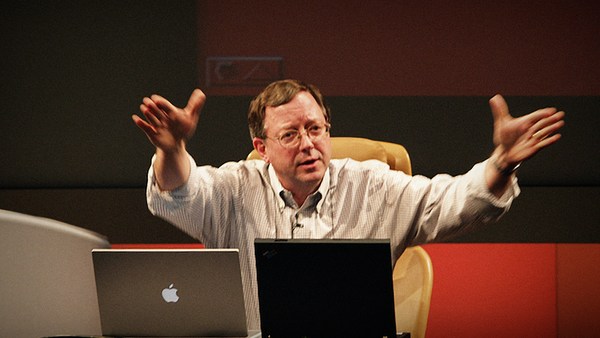I am going to be talking about secrets. Obviously the best way to divulge a secret is to tell someone to not say anything about it. (Laughter) Secrets. I'm using PowerPoint this year just because, you know, I'm into the TED thing. (Laughter) And when you use these things you don't have to go like that. You just press it. (Laughter) Oh, man. Um, yes. (Laughter) Yes. I'm sure! Just change it! (Laughter) Is Bill Gates here? Change it! Come on! What? (Laughter) Ah! Okay. That's not my slides, but it's okay. (Laughter)
As you can see, these are all maps. And maps are important devices for transferring information, especially if you have human cognitive ability. We can see that all formulas are really maps. Now, as humans, we make maps of places that we seldom even go, which seems a little wasteful of time.
This, of course, is a map of the moon. There're some very delightful names. Tranquilacalitis, [unclear]. My favorite is Frigoris. What are these people thinking? Frigoris? What the Frigoris you doing? Names are important. Frigoris? This is the Moon. People could live there one day. I'll meet you at Frigoris. No. I don't think so. (Laughter)
There we see Mars, again with various names. And this is all done, by the way, by the International Astronomical Union. This is an actual group of people that sit around naming planetary objects. This is from their actual book. These are some of the names that they have chosen, ladies and gentlemen.
I'll go through a little of them. Bolotnitsa. That, of course, is the Slavic swamp mermaid. (Laughter) Now I think the whole concept of a mermaid doesn't really blend into the swamp feel. (Laughter) "Oh look! Mermaid come out of swamp. Oh boy! It's time for Bolotnitsa!" (Laughter)
Djabran Fluctus. If that don't flow off the tongue, what does? (Laughter) I mean kids are studying this stuff and they've got the word "fluctus" up there. That's wrong. (Laughter) One dyslexic kid and he could be ruining his life. (Laughter) "It fluctus up, Mama."
Hikuleo Fluctus. That's a little more flowing. Hikuleo sounds like a kind of a Leonardo DiCaprio 17 syllable thing. And that's the Tonga underworld.
And one of my favorites is the Itoki Fluctus, who is the Nicaraguan goddess of insects, stars, and planets. Now, if you're a goddess of stars and planets wouldn't you relegate insects to somebody else? (Laughter) "No, no, really, I'm so busy with the stars. Would you mind taking the insects? Thank you darling. Oh take the spiders too. I know they're not insects, but I don't care. Monkeys, chimps, just get rid of the hairy creatures." (Laughter)
Now, we're going to be going to Mars one day. And when we do, it's going to be unfair for the people that are living there to have to live with these ridiculous names. So, you'll be on Mars, and you're at Hellespointica Depressio which has got to be a really "up" place. (Laughter)
Yeah, I'm at the Depressio, and I want to get over to Amazonis so I plug it into the Mars map, and click the button and there's my directions. I go to Chrysokeras. (Laughter) Left to the Thymiamata. Then to Niliacus Lacus, which is not a bad name. Niliacus Lacus, try to get the practice, slick-a-tick-a-bacus. That's a cool name. I will say that. So, I hold back a little of my venom for these astronomical misnomers.
And then of course Arnon to Thoth. And of course there will be advertisements. This is from their rule book, the International Astronomical Union. And you know they're international because they put it "en Francais" as well. L'Union Astronomique Internationale, for those of you who don't speak French. I thought I'd translate for you.
From the rulebook: Nomenclature is a tool. The first consideration, make it clear, simple and unambiguous. And I think that Djabran Fluctus, that fits that mode. (Laughter) That's simple, the goddess of goats, very simple. Djabran Fluctus. "Now, Frank is this clear to you, Djabran Fluctus?" "Yeah, that's the goat goddess right? The Abacazanian? (Laughter) It's clear to me." "Listen, I'm going back to the swamp mermaid. Can you call me in a little while?" (Laughter)
Also, from the actual document I highlighted a part I thought may be of interest. Anyone can suggest changing a name. So, I look to you, fellow member of the Earth community. We've got to change this stuff up fast. So, these are actual names of people that work there. I did some more investigation. These are more people working for this group. And, as you can see, they don't use their first names. (Laughter) These are people naming planets, and they won't use their first names. Something is askew here. (Laughter) Is it because his name is really Jupiter Blunck? (Laughter) Is that Ganymede Andromeda Burba? (Laughter) Is that Mars Ya Marov? I don't know. But it's investigative material, no doubt.
There are some mapping people who do use their names. Witness please, Eugene Shoemaker, who, diligently, from a young boy decided he wanted to make maps of celestial bodies. Must have been a very interesting day in the Shoemaker house. "Mom, I want to make maps." "That's wonderful Eugene. You could make maps of Toronto." "No, I want to make maps of planets." "Yeah, go to your room." (Laughter)
Martians, Venusians, Jovians. We have names for places where people don't exist. That seems a little silly to me. There are no Jovians.
Getting back to my premise, I used stamps, by the way, because you don't have to pay anybody for the rights. (Laughter) (Applause) There is obviously Einstein, Niels Bohr, de Fermat's last theorem, and I'm not sure whether that's James Coburn or Richard Harris. (Laughter) It's definitely one of the two. I'm not really clear which one.
But obviously the point is that numbers are maps. And within numbers, is there an underlying secret to the universe? That is the premise of this particular presentation. By the way, that's a natural picture of Saturn, no adjustments. I mean that's just beautiful. So beautiful that I will even give up a laugh to explain my love of this particular planet, and the day Saturday, named after it, wonderfully.
So, formulas relate number to form. That's Euler, his formula was one of the inspirations that lead to the beginning of string theory which is kind of cool, not that funny, but it is cool. (Laughter) He was also famous for having no body. (Laughter) Which a lot of you are like, "How did he figure that out?" He's got no body, no man, just a head floating high. Here comes Euler. (Laughter)
And that's an icosahedron, which is one of the five sacred solids, very important shapes. You see the icosahedron again. The dodecahedron, it's dual. There is a dodecahedron which I had to do in my room last night. The five sacred solids, as you can see there. Which is not to be confused with the five sacred salads. (Laughter) Blue cheese, ranch, oil and vinegar, thousand islands and house. I suggest the house.
The reality, now here is something important. What's important about this is these shapes are duals of each other. And you can see how the icosahedron withdraws into the dodecahedron and then they just merge into each other. So, the whole concept of branes in the universe, if the universe is shaped like a dodecahedron this is a very good map of what could possibly be. And that is, of course, what we are here to talk about.
What a coincidence! October 9th, in France, Jean-Pierre Luminet said that the universe is probably shaped like a dodecahedron, based on information that they got from this probe. This would be a normal wave pattern. But what they're seeing, way out there in the far reaches of the microwave background, is this kind of odd undulation. It doesn't plug in to what they suspected a flat universe would be.
So, you can kind of get an idea from this extrapolating that back under this huge picture, so we get this idea of what the primal universe looked like. And judging from this, it looks a little like a cheeseburger. (Laughter) So, I'm thinking the universe is either a dodecahedron or a cheeseburger. And for me, that's a win-win. Everybody goes, I'm happy. (Laughter) Better really hurry up.
I just threw this in because as important as all of our intellectual abilities are, without heart and without love it's just -- it's all meaningless. And that, to me, is really beautiful. (Laughter) Except for that creepy guy in the background. (Laughter)
Getting back to the point of my particular presentation, Kepler, one of my great heroes, who realized that these five solids, which I spoke of earlier, were related somehow to the planets, but he couldn't prove it. It freaked him out. But it did lead to Newton discovering gravity. So, maps of things leading to organized understandings of the universe in which we emerge.
Now this is Isaac from a Vietnamese stamp. (Laughter) I am not suggesting at all that my Vietnamese brothers and sisters could maybe use a little art class here and there. But ... (Laughter) that's not a good picture. (Laughter) Not a good picture. Now, my friends in the island of Nevis are a little better. Look at that! That's Isaac Newton. That guy is rockin'. (Laughter) What a handsome cat.
Once again, Nicaragua let me down. (Laughter) And Copernicus looks like Johnny Carson, which is really weird. (Laughter) I don't get that at all. Once again, these guys rock it out. Isaac is kickin' ass. Man, he looks like a rock star. This is freaky is a major way. This is Sierra Leone. They got little babies in there, floating in there. (Laughter)
Man. I don't really need to comment on this. But I didn't know that Isaac Newton was in the Moody Blues. Did you? (Laughter) When did this happen? (Laughter) It's a different kind of course. And they've got five apples? I mean these guys are extrapolating in realms that are not necessarily valid. Although five is a good number, of course.
Ecuador, my friend Kepler, as you can see, they call him Juan. (Laughter) Juan? No! Johannes, not Juan. It wasn't Carlos Chaplain. It's wrong. (Laughter)
René Descartes, of course. Once again these Grenada people, this is like way too sick for anybody's imagination. He's all murky. There is little kids leaning on his leg, little ghosts flying around. We gotta clean this stuff up fast, ladies and gentlemen. (Laughter)
This is, of course, the Cartesian coordinates. Once again, that's Sierra Leone. This is again, indicating how numbers relate to space relate to form, maps of the universe. Because that's why we're here, really, I think to figure stuff out and to love each other.
Descartes. (Laughter) Before the horse. (Laughter) Now, Monaco took Descartes, and just flipped him around. Now, Monaco is problematic for me, and I'll show you why. Here is a map. All they have is a casino on it. (Laughter) And why Franklin Delano Roosevelt is on their map I don't even want to hazard a guess. But I'd say he'd been to Hellespointica Depressio recently. (Laughter)
This is the flag of Monaco. Ladies and gentlemen, the flag of Indonesia. Please examine. (Laughter) (Applause) Not sure how this came to be, but it's not right. In Monaco, "No, what are you talking about? They are so different. Look, ours is more red, it's longer. They stole our flag! They stole our flag!" (Laughter)
Bode's law wasn't even his law. It was a guy named Titus. And the reason I just bring this up because it is a law that doesn't really work. That's Jude Law and some of his films recently didn't work. (Laughter) Just a correlation that indicates how things are misinterpreted.
And I wonder if the photographer said, "Okay, Jude, could you touch your tooth? That's good." Just a tip, if you're being photographed for press pictures, don't touch your teeth. (Laughter)
Prime numbers, Gauss, one of my favorites. Golden section, I've been obsessed with this thing since before I was born. I know that scares a lot of you, but that was my purpose entirely. There we can see Fibonacci numbers related to the Golden Section, because Fibonacci and Golden Section relate to the unfolding of the measured meter of matter, as I refer to it. If Fibonacci had been on Paxil, (Laughter) that would be the Fibonacci series. "Ten milligram, 20 milligram." "Leonardo, dinner's ready, put down those books and take your pills." "Yes, Mama." (Laughter)
Alright where is this going? That's a good question. Here is the premise that I began 27 years ago. If numbers can express the laws of this incredible universe that we live, I reason, through some sort of reverse engineering, we could extrapolate from them some basic structural element of this universe. And that's what I did. Twenty-seven years ago I started working on this.
And I tried to build a particle accelerator. (Laughter) And that didn't work out well. So, then I thought a calculator is a metaphor. I can just divide numbers, that's like atom smashing. That's what I did. That's how I found Moleeds. Moleeds are what I believe the thing that will allow string theory to be proved. They are the nodes on the string, patterns and relationships, 27, 37. That was the first chart I came up with.
You can see, even if you don't go for the numbers, the beauty of the symmetry. The numbers from one to 36, divided into six groups. Symmetry, pairs. Every top adds up to 37. Bottom, all 74. There is so many intricate relationships that I'm not going to go there now, because you would say, "Hey, go back to the Fluctus part." (Laughter)
Circle of Fifths, acoustic harmony, geometric symmetry. I knew those two were related. Once again, the Cartesian kind of cross-over. So, I said if I'm going to put a circle, see what kind of patterns I get, boom, the Red System. Look at that. You can't just make this stuff up, ladies and gentlemen. (Laughter) You can't just go around going, "Oh, I'm going to put some triangles in a circle and they're going to be symmetrical. And they're all going to add up, and it's going to be, oh yeah, I figured that out."
This is beyond anything anybody could just make up. There is the Orange System. (Laughter) And you'll see over here, these are multiples of the number 27. And they recapitulate that shape, even though that's a circle of nine and that's a circle of 36. It's nuts. (Laughter) That's the Green System. It all folds in half on the Green System, right between 18 and 19. The Blue System. The Violet. It's all there. (Laughter) Look at that! I mean you cannot make that stuff up. (Laughter) That just doesn't fall out of a tree, ladies and gentlemen. Twenty-seven years of my life! (Laughter) And I'm presenting it here at TED. Why? Because this is the place if aliens land, I hope they come here. (Laughter) "We are going to destroy the Earth. Hmmm ... maybe not." (Laughter)
In this last year I have found these subsequent systems which allow for the mathematic possibilities of the Calabi-Yau manifolds in a way that doesn't necessitate these little hidden dimensions. Which works mathematically, but it just doesn't seem God-like to me. It just seems like it's not sexy and elegant, it's hidden. I don't want hidden, I want to see it. (Laughter)
I found other pairs all have symmetry, even though, unlike the master one, their symmetry is split. Unbelievable. This is like crazy. Am I the only one that sees this? (Laughter) You know, I didn't just draw this in a day, by the way. You know, try making some charts like this at home. You gotta be accurate! There's measurement involved, increments. These are maps, by the way. Not stamps, but one day. (Laughter)
Okay, I'm getting to the punch. Golden Ratio, it's crazy. And look at this, built within it is the Golden Ratio. I start looking at that, and look at them again. They start looking like planets. I go to JPL. I look at the orbits of the planets. I find 18 examples of it in our solar system. I never told anybody. This is the first thing. This could be history. (Laughter) Kepler was right. (Laughter) Eighteen and 19, the middle of the Moleeds, 0.618 is the golden section. Multiply them together, 18.618 x 19.618 is 365.247. Which is .005 different from the number of days in a year.
Hey, you can't make this up. (Laughter) Thank you very much. (Applause) Thank you. (Applause) Thank you. (Applause)





